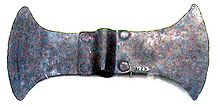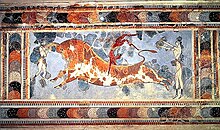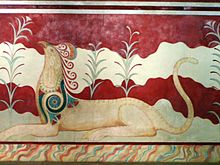Knossos
This article includes a list of general references, but it lacks sufficient corresponding inline citations. (March 2011) |

Knossos (alternative spellings Knossus, Cnossus, Greek Κνωσός pronounced [knoˈsos]), also known as Labyrinth, or Knossos Palace, is the largest Bronze Age archaeological site on Crete and probably the ceremonial and political centre of the Minoan civilization and culture. The palace appears as a maze of workrooms, living spaces, and store rooms close to a central square. Detailed images of Cretan life in the late Bronze Age are provided by images on the walls of this palace. It is also a tourist destination today, as it is near the main city of Heraklion and has been substantially restored by archaeologist Arthur Evans.
The city of Knossos remained important through the classical and Roman periods, but its population shifted to the new town of Chandax (modern Heraklion) during the 9th century AD. By the 13th century, it was called Makryteikhos 'Long Wall'; the bishops of Gortyn continued to call themselves Bishops of Knossos until the 19th century.[1] Today, the name is used only for the archaeological site situated in the suburbs of Heraklion.
Discovery and excavation

The ruins at Knossos were discovered in 1878 by Minos Kalokairinos, a Cretan merchant and antiquarian. He conducted the first excavations at Kephala Hill, which brought to light part of the storage magazines in the west wing and a section of the west facade. After Kalokairinos, several people attempted to continue the work, and Heinrich Schliemann had previously showed an interest[citation needed] but it was not until March 16, 1900 that archaeologist Sir Arthur Evans, an English gentleman of independent means, was able to purchase the entire site and conduct massive excavations. The excavation and restoration of Knossos, and the discovery of the culture that he labeled Minoan, is inseparable from Evans. Assisted by Dr. Duncan Mackenzie, who had already distinguished himself by his excavations on the island of Melos, and Mr. Fyfe, the British School at Athens architect, Evans employed a large staff of local laborers as excavators and within a few months had uncovered a substantial portion of what he named the Palace of Minos. The term 'palace' may be misleading: in modern English, it usually refers to an elegant building used to house a head of state or similar. Knossos was an intricate collection of over 1,000 interlocking rooms, some of which served as artisans' workrooms and food-processing centers (e.g. wine presses). It served as a central storage point, and a religious and administrative center. The throne room that was discovered was repainted by a father-and-son team of artists, both named Émile Gilliéron, at Arthur Evans' command. Evans based the recreations on archaeological evidence, but drew criticism from some quarters, because some of the best-known frescoes from the throne room are believed to be inventions of the Gilliérons.[2]
The site has had a very long history of human habitation, beginning with the founding of the first Neolithic settlement circa 7,000 BC. Over time and during several different phases that had their own social dynamic, Knossos grew until, by the 19th to 16th centuries BC (during the 'Old Palace' and the succeeding 'Neo-palatial' periods), the settlement possessed not only a monumental administrative and religious center (i.e., the Palace), but also a city with a population of up to 100,000.[3] The site was destroyed by fire but has been reconstructed.
Legend

The palace is about 130 meters on a side and since the Roman period has been suggested as the source of the myth of the Labyrinth, an elaborate mazelike structure built for King Minos of Crete and designed by the legendary artificer Daedalus to hold the Minotaur, a creature that was half man and half bull and was eventually killed by the Athenian hero Theseus.
"Labyrinth" may have come from labrys, a word that refers to a double, or two-bladed, axe. Its representation had religious and probably magical significance. It was used throughout the Mycenaean world as an apotropaic symbol: the presence of the symbol on an object would prevent it from being "killed". Axes were scratched on many of the stones of the palace. It appears in pottery decoration and is a motif of the Shrine of the Double Axes at the palace, as well as of many shrines throughout Crete and the Aegean. The first written attestation of the word 'labyrinth' is believed by many linguists to feature on a Linear B tablet as da-pu2-ri-to-jo po-ti-ni-ja, 'lady of the Labyrinth', which makes the etymology connecting it to labrys less likely. Whatever the word's ultimate origin, it must have been borrowed by the Greeks, as the suffix labyr-inthos uses a suffix generally considered to be pre-Greek.
The location of the labyrinth of legend has long been a question for Minoan studies. It might have been the name of the palace or of some portion of the palace. Throughout most of the 20th century the intimations of human sacrifice in the myth puzzled Bronze Age scholars, because evidence for human sacrifice on Crete had never been discovered and so it was vigorously denied. The practice was finally confirmed archaeologically (see under Minoan civilization). It is possible that the palace was a great sacrificial center and could have been named the Labyrinth. Its layout certainly is labyrinthine in the sense that it is intricate and confusing.
Many other possibilities have been suggested. The modern meaning of labyrinth as a twisting maze is based on the myth.
Several out-of-epoch advances in the construction of the palace are thought to have generated the myth of Atlantis.[citation needed]
Art and architecture
Description of Palace

The great palace was gradually built between 1700 and 1400 BC, with periodic rebuildings after destruction. Structures preceded it on Kephala hill. The features currently most visible date mainly to the last period of habitation, which Evans termed Late Minoan. The palace has an interesting layout[4] – the original plan can no longer be seen due to the subsequent modifications. The 1,300 rooms are connected with corridors of varying sizes and direction, which differ from other contemporaneous palaces that connected the rooms via several main hallways. The 6 acres (24,000 m2) of the palace included a theater, a main entrance on each of its four cardinal faces, and extensive storerooms (also called magazines). Within the storerooms were large clay containers (pithoi) that held oil, grains, dried fish, beans, and olives. Many of the items were processed at the palace, which had grain mills, oil presses, and wine presses. Beneath the pithoi were stone holes that were used to store more valuable objects, such as gold. The palace used advanced architectural techniques: for example, part of it was built up to five storeys high.
Water management
The palace had at least three separate water-management systems: one for supply, one for drainage of runoff, and one for drainage of waste water.
Aqueducts brought fresh water to Kephala hill from springs at Archanes, about 10 km away. Springs there are the source of the Kairatos river, in the valley in which Kephala is located. The aqueduct branched to the palace and to the town. Water was distributed at the palace by gravity feed through terracotta pipes to fountains and spigots. The pipes were tapered at one end to make a pressure fit, with rope for sealing. The water- supply system would have been manifestly easy to attack.[citation needed] No hidden springs have been discovered as at Mycenae.
Sanitation drainage was through a closed system leading to a sewer apart from the hill. The queen's megaron contained an example of the first water-flushing system toilet adjoining the bathroom. This toilet was a seat over a drain that was flushed by pouring water from a jug. The bathtub located in the adjoining bathroom similarly had to be filled by someone heating, carrying, and pouring water, and must have been drained by overturning into a floor drain or by bailing. This toilet and bathtub were exceptional structures within the 1,300-room complex.
As the hill was periodically drenched by torrential rains, a runoff system was a necessity. It began with channels in the flat surfaces, which were zigzag and contained catchment basins to control the water velocity. Probably the upper system was open. Manholes provided access to parts that were covered.
Some links to photographs of parts of the water-collection-management system follow.
- Runoff system.[5] Sloped channels lead from a catchment basin.
- Runoff system.[6] Note the zig-zags and the catchment basin.
Ventilation
Due to its placement on the hill, the palace received sea breezes during the summer. It had porticoes and air shafts.
Minoan Columns
The palace also includes the Minoan column, a structure notably different from other Greek columns. Unlike the stone columns that are characteristic of other Greek architecture, the Minoan column was constructed from the trunk of a cypress tree, common to the Mediterranean. While most Greek columns are smaller at the top and wider at the bottom to create the illusion of greater height (entasis), the Minoan columns are smaller at the bottom and wider at the top, a result of inverting the cypress trunk to prevent sprouting once in place.[7] The columns at the Palace of Minos were painted red and mounted on stone bases with round, pillow-like capitals.
Frescoes

Frescoes decorated the walls.[8] Since the remains were only fragments, fresco reconstruction and placement by the artist Piet de Jong is controversial. These sophisticated, colorful paintings portray a society which, in comparison to the roughly contemporaneous art of Middle and New Kingdom Egypt, was either conspicuously non-militaristic or did not choose to portray military themes anywhere in their art. (See Minoan civilisation) As with contemporaneous Egyptian art, male figures are often shown with darker or redder skin than female figures; though not certain, the differentiation might be related to cultural ideals which placed women in protected settings and men in outdoor settings. Many of the extant images depict young or ageless adults, with few young children or elders depicted. In addition to scenes of men and women linked to activities such as fishing and flower gathering, the murals also portray athletic feats. The most notable of these is bull-leaping, in which an athlete grasps the bull's horns and vaults over the animal's back. One remaining question is whether this activity was a religious ritual, possibly a sacrificial activity, or a sport, perhaps a form of bullfighting. Many people[who?] have questioned whether this activity is even possible; the fresco might represent a mythological dance with the Great Bull. The most famous example is the Toreador Fresco, painted around 1550–1450 BC, in which a young man, flanked by two women, apparently leaps onto and over a charging bull's back. It is now located in the Archaeological Museum of Herakleion in Crete.
Throne Room

The centerpiece of the "Minoan" palace was the so-called Throne Room or Little Throne Room,[9] dated to LM II. This chamber has an alabaster seat identified by Evans as a "throne" built into the north wall. On three sides of the room are gypsum benches. A sort of tub area is opposite the throne, behind the benches, termed a lustral basin, which means that Evans and his team saw it as a place for ceremonial purification.
The room was accessed from an anteroom through two double doors. The anteroom as connected to the central court, which was four broad steps up through four doors. The anteroom had gypsum benches also, with carbonized remains between two of them thought to possibly be a wooden throne. Both rooms are located in the ceremonial complex on the west of the central court.

The throne is flanked by the Griffin Fresco, with two griffins couchant (laying down) facing the throne, one on either side. Griffins were important mythological creatures, also appearing on seal rings, which were used to stamp the identities of the bearers into pliable material, such as clay or wax.
The actual use of the room and the throne is unclear. The two main theories are as follows:
- The seat of a priest-king or his consort, the queen. This is the older theory, originating with Evans. In that regard Matz speaks of the "heraldic arrangement" of the griffins, meaning that they are more formal and monumental than previous Minoan decorative styles. In this theory, the Mycenaean Greeks would have held court in this room, as they came to power in Knossos at about 1450. The "lustral basin" and the location of the room in a sanctuary complex cannot be ignored; hence, "priest-king."
- A room reserved for the epiphany of a goddess,[10] who would have sat in the throne, either in effigy, or in the person of a priestess, or in imagination only. In that case the griffins would have been purely a symbol of divinity rather than a heraldic motif.
It is also speculated that the throne was made specifically for a female individual, since the indentation seems to be shaped for a woman's buttocks. Also, the extensive use of curved edges and the crescent moon carved at its base both symbolize femininity.
The lustral basin was originally thought to have had a ritual washing use, but the lack of drainage has more recently brought some scholars to doubt this theory. It is now speculated that the tank was used as an aquarium, or possibly a water reservoir.
Society
A long-standing debate between archaeologists concerns the main function of the palace, whether it acted as an administrative center, a religious center, or both, in a theocratic manner. Other important debates consider the role of Knossos in the administration of Bronze Age Crete, and whether Knossos acted as the primary center, or was on equal footing with the several other contemporaneous palaces that have been discovered on Crete. Many of these palaces were destroyed and abandoned in the early part of the 15th century BC, possibly by the Mycenaeans, although Knossos remained in use until it was destroyed by fire about one hundred years later. Knossos showed no signs of being a military site; for example, it had neither fortifications nor stores of weapons.
Notable residents
- Aenesidemus (1st century BC) sceptical philosopher
- Chersiphron (6th century BC) architect
- Epimenides (6th century BC) seer and philosopher-poet
- Ergoteles of Himera (5th century BC) expatriate Olympic runner
- Metagenes (6th century BC) architect
- Minos (mythical) Father of the Minotaur
See also
References
- ^ Oliver Rackham and Jennifer Moody (1996). The Making of the Cretan Landscape. Manchester University Press. pp. 94, 104. ISBN 0-7190-3646-1.
- ^ Gere, Cathy Knossos and the Prophets of Modernism (Chicago: The University of Chicago Press, 2009), p. 111 ISBN 0226289540.
- ^ European Kingdoms. Ancient Greece. Historyfiles.co.uk (2011-06-23). Retrieved on 2012-01-02.
- ^ Plot plans of the palace are given at the following sites: 1, 2, 3, 4, 5)
- ^ JPEG image. UK.digiserve.com. Retrieved on 2012-01-02.
- ^ JPEG image. Dartmouth.edu. Retrieved on 2012-01-02.
- ^ C. Michael Hogan, Knossos fieldnotes, Modern Antiquarian (2007)
- ^ Knossos: Fakes, Facts, and Mystery. Nybooks.com (2009-08-13). Retrieved on 2012-01-02.
- ^ Matz, The Art of Crete and Early Greece Kessinger Publishing, LLC, 2010, ISBN 1163815446, uses this term.
- ^ Peter Warren: Minoan Religion as Ritual Action, Volume 72 of Studies in Mediterranean Archaeology, 1988, the University of Michigan
35°17′52.66″N 25°9′47.36″E / 35.2979611°N 25.1631556°E
Bibliography
- Benton, Janetta Rebold and Robert DiYanni.Arts and Culture: An introduction to the Humanities, Volume 1 (Prentice Hall. New Jersey, 1998), 64–70.
- Bourbon, F. Lost Civilizations (New York, Barnes and Noble, 1998), 30–35.
- Landenius Enegren, Hedvig. The People of Knossos: prosopographical studies in the Knossos Linear B archives (Uppsala: Acta Universitatis Upsaliensis, 2008) (Boreas. Uppsala studies in ancient Mediterranean and Near Eastern civilizations, 30).
External links
- Hellenic Ministry of Culture
- British School at Athens Knossos Pages. This site contains an Activex tour with moving panoramas through the palace.
- Aegean Prehistory Online at Dartmouth
- Knossos on Wikimapia
- The Palaces of Minos at Knossos, Athena Review, Vol.3, no.3
- Knossos Palace informations
